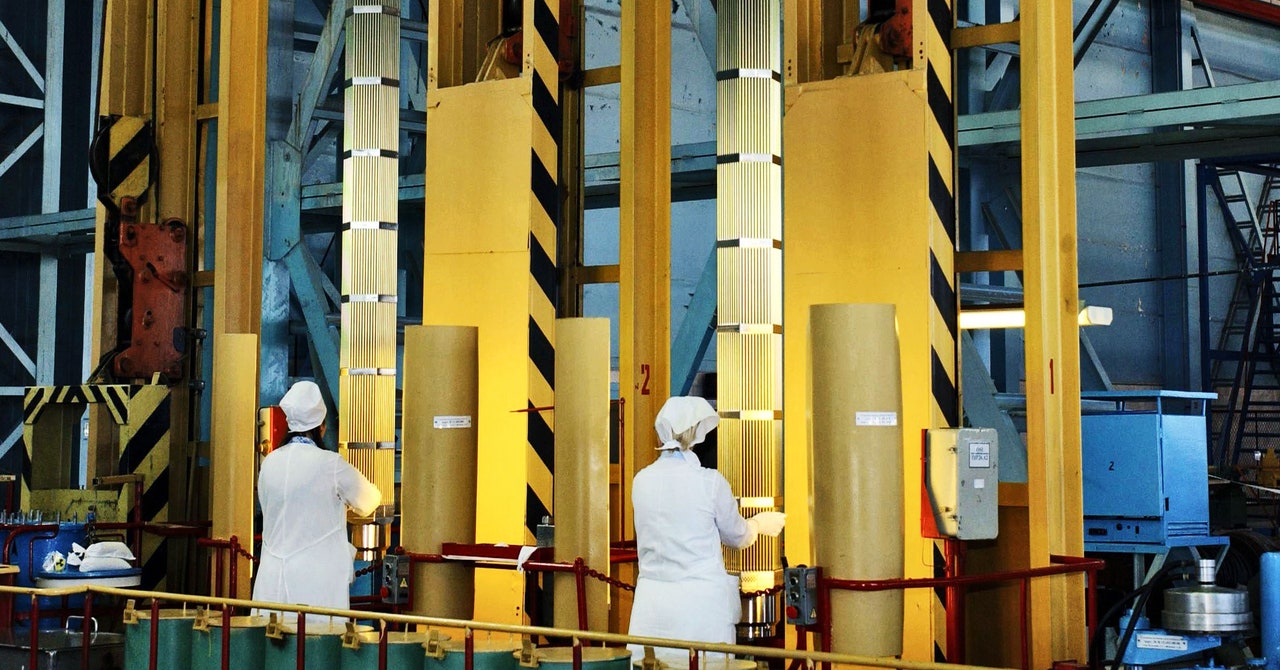
Say you want to make nuclear fuel: Take some uranium, and with molecular wizardry, transform this heavy metallic element into a gas. Then put it in a centrifuge and whirl it around in a radioactive tornado, until the lightest particles cluster towards the center. Those are the molecules containing the uranium isotope 235. That’s the isotope for you, because it can produce energy when it’s split. Do this again and again in a series of centrifuges known as a cascade, siphoning off the U-235 each time, and pretty soon you’ll have low-enriched uranium, fuel for a traditional nuclear reactor. Go long enough and you’ll eventually reach high enrichment—and perhaps have the makings of a bomb.
A few weeks ago, if you had asked Jeff Navin, who runs government policy at TerraPower, a nuclear power startup backed by Bill Gates, where he would have expected the first batch of fuel for his company’s new reactors to be produced, he would have had a straightforward answer: Russia. Advanced reactor designs like TerraPower’s are only proposals right now, but they promise to be safer and svelter than the massive plants of today. The hope is that they might reinvigorate nuclear energy in the United States and in Europe, where old reactors are closing faster than new ones are being built. In the US, only two plants are under construction, and they have experienced massive delays and cost overruns. In theory, advanced reactors could be cheaper to build, offering a complement to renewable energy sources like wind and solar.
But to make that happen, they require a special kind of fuel that can deliver energy in a smaller, more efficient package. Not 5 percent enriched uranium, like the fuel for today’s nuclear power plants, but up to 20 percent U-235, which is the cutoff for “highly enriched” uranium. Right now, the only place that can enrich uranium to that sweet spot is Russia. In particular, it’s made by a company called Tenex, a subsidiary of the government’s nuclear energy company, Rosatom. In 2020, when the Department of Energy announced its Advanced Reactor Demonstration Program—including a $160 million award split between TerraPower and its competitor X-Energy to build pilot reactors by 2027—it was clear that Russia would be the initial source of fuel.
Then came the war in Ukraine. “It’s definitely changed our plans,” says Navin. “We have no interest in supporting a Russian state-owned entity.” There were always concerns, he says, about depending on Russian fuel. The company’s original plan was to fuel up the first reactor with Russia’s help and then switch over to a domestic supply chain that would have been built up in the interim. Now, along with many of his colleagues and competitors in the advanced reactor industry, Navin is scrambling to figure out where else to find that fuel without derailing their timeline.
The need for that fuel—called HALEU, or high-assay low-enriched uranium—is mostly theoretical, because no advanced reactors actually exist yet. Currently, US demand for the stuff is limited to the military, to isotopes for medical treatments, and to space research applications, like possible energy systems for spacecraft. The National Nuclear Security Administration has set aside enough enriched uranium to satisfy those needs until 2060. Russia, however, is actively enriching new HALEU, in part because it maintains a small fleet of older-style plants that use higher-grade fuel. Although the nuclear industry is—along with imports of natural gas and nickel for electric car batteries—so far exempted from recent sanctions, Russian uranium is now considered radioactive by American businesses.
“Frankly, let’s be real. I don’t think that option’s on the table,” says Jacob DeWitte, CEO of Oklo, a Silicon Valley startup designing its own HALEU-dependent reactor. “Right now there’s a real gap: We can’t import it, and we can’t produce it yet.”
Of all the ways to make HALEU, the fastest way for the US to spin up production would involve “down-blending” the highly enriched uranium it already has. This process, which involves mixing it with unenriched metal, has been done plenty of times before. A few decades ago, when the Cold War was winding down, the military had an unexpected problem: too much weapons-grade uranium. Non-proliferation treaties with Russia and other countries meant the world wanted fewer nuclear weapons, so the military took stock of the enriched uranium it had and turned the excess into fuel for standard reactors—that is, 5 percent enrichment, or below HALEU status. At the time, there was little protest. Who wants to have a bunch of weapons-grade uranium sitting around when it could be used for clean power?
Now the advanced reactor industry is looking back on those decisions with some regret. “Nobody would be losing any sleep right now if we still had a bank of fuel,” DeWitte says. He and others in the industry are advocating for the military to revisit whether its remaining stocks can be converted to HALEU, though DeWitte acknowledges that “borrowing” nuclear resources from the government would be politically dicey.


